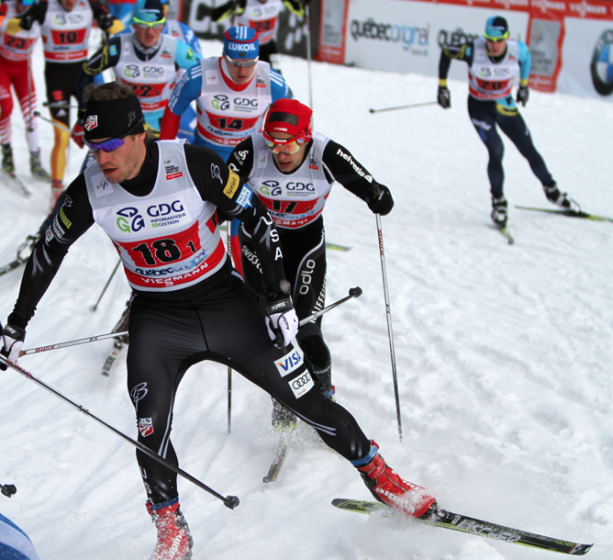
Team sprint strategy on Sunday in Liberec, Czech Republic, seemed to be pretty standard: start slowly, put minimal effort into the middle and ramp up the pace in the last few laps. In the men’s semifinal round the tactics were no different for the first few legs of the relay, Simi Hamilton and Andy Newell were able to sit in third or fourth and keep the U.S. with the leaders.
“Andy and I were having a great semifinal right before I tagged off to him for the last leg,” Hamilton said in an email from Liberec.
It was at that critical stage, as the pace began to increase, that Hamilton got unlucky. Just before the last exchange Matias Strandvall (FIN II) caught his ski on a V-board and went down right in front of Hamilton, causing the American to spin around and lose time on the leaders.
“I did my best to avoid going down with him, but unfortunately my skis tangled underneath him and I got spun 180,” Hamilton said. “I did end up saving myself from going down, but we probably lost about five-plus seconds on the leaders once I could get myself sorted out.”
Such is sprint racing. Newell was able to scramble back onto the pack and re-pass the teams that had moved ahead of Hamilton to bring the U.S. to fifth place at the finish, only 1.6 seconds behind the winner in the first of two semifinals.
“I thought our heat finished pretty fast,” Newell said. “Simi got spun around a little bit so we lost a little time on the last tag, [but] I think we both felt pretty good.”
Only two teams auto-advance to the finals in team sprints and six lucky losers move on between the two heats. Before the second heat finished the Americans thought they had a shot at being one of them, but the second round ended up being 10 seconds faster than the first. Perhaps benefitting from the knowledge of the first heat’s splits, the top eight teams from semifinal two moved on to compete for the podium and Newell and Hamilton ended their day early.
“I thought we were looking good for making the finals but it just didn’t happen,” Newell said. “In the second semi there were two teams from Norway and two from Germany. Any time you get that many pairs you know they’re going to push the pace pretty hard.
“But I think we both felt pretty good so that’s a good sign.”
Hamilton agreed. “It was for sure a disappointing and unlucky end to our day, but I think we skied well and we’ll just be more fired up for the next team sprint in Sochi,” he said.
Just how important is it to be in the second semifinal of a team sprint? It’s hard to say. This time, because the 1.7 k course was longer than usual, Newell felt it mattered a great deal. Team sprints used to work such that more teams from each heat automatically advanced and there were fewer lucky losers. Since FIS adopted the present rules, Newell thinks the longer courses have made the format even more dogged in the early heats, contrary to the original intent of the change.
“I liked it better when they used to move on four from each heat and have only two lucky losers,” Newell said. “On a day like today where it’s such a long race, the second semi was getting all kinds of splits. At first they were running ten seconds down and they’re getting all that information from their coaches, so by the time they’re on their last lap they know that and they’re able to push the pace more and more.”
While Hamilton and Newell ended their day earlier than desired, the second American team of Skyler Davis and Erik Bjornsen racked up team sprint experience.
The duo finished 14th out of 14 teams in the first semifinal, 52.2 seconds off the winners. Bjornsen anchored and was focused simply on maintaining contact with the leaders for as long as he could. When the team lost the pack in the third leg, Bjornsen produced an impressive second-fastest fourth leg split in an attempt to put them back in the race.
“I almost beat the Polish dude (Pawel Klisz) who started about five to ten seconds in front of me,” Bjornsen said. “We had a good sprint to the finish. He got me though, I had spent all my energy trying to catch him.”
Bjornsen has brought his sprinting and distance skiing along well this year, and his competency in both disciplines suit him well in team sprints like Liberec where three segments on the 1.7 k course adds up to over 5 k.
“I really like the format,” Bjornsen said. “I like it because it is a lot like a distance race, so I think it really favors the sprinters that can distance ski.”
World Cup action resumes next weekend in La Clusaz, France, with a 10/15 k mass start classic on Saturday and 4 x 5 / 4 x 7.5 relay on Sunday.
Audrey Mangan
Audrey Mangan (@audreymangan) is an Associate Editor at FasterSkier and lives in Colorado. She learned to love skiing at home in Western New York.



